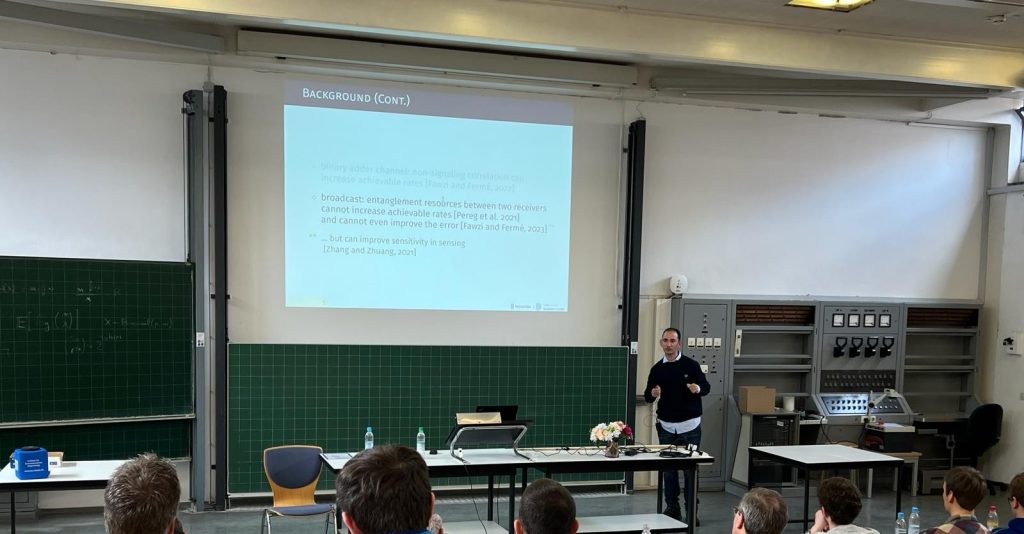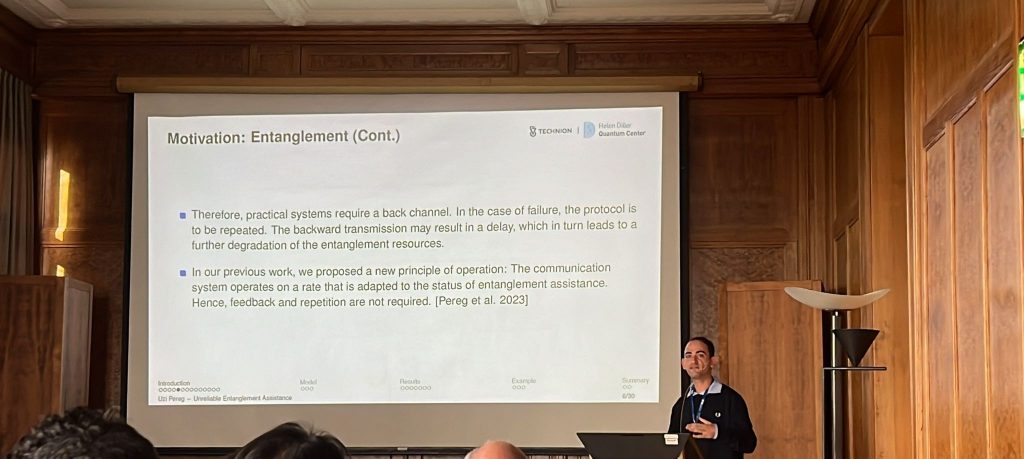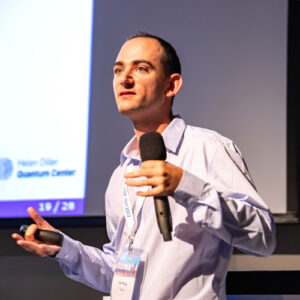
 Speaker: Prof. Uzi Pereg
Speaker: Prof. Uzi Pereg
Communication over a classical multiple-access channel (MAC) with entanglement resources is considered, whereby two transmitters share entanglement resources a priori before communication begins. Leditzky et al. (2020) presented an example of a classical MAC, defined in terms of a pseudo telepathy game, such that the sum rate with entangled transmitters is strictly higher than the best achievable sum rate without such resources. Here, we establish inner and outer bounds on the capacity region for the general MAC with entangled transmitters, and show that the previous result can be obtained as a special case. It has long been known that the capacity region of the classical MAC under a message-average error criterion can be strictly larger than with a maximal error criterion (Dueck, 1978). We observe that given entanglement resources, the regions coincide. Furthermore, we address the combined setting of entanglement resources and conferencing, where the transmitters can also communicate with each other over rate-limited links. Using superdense coding, entanglement can double the conferencing rate.
 Quantum communication has seen rapid development in the last decade, in both practice and theory. Entanglement resources are instrumental in a wide variety of quantum network frameworks. In particular, entanglement assistance can increase transmission rates substantially. Unfortunately, entanglement is a fragile resource that is quickly degraded by decoherence effects. To generate entanglement for optical communication, the transmitter first prepares an entangled photon pair locally, and then transmits a photon to the receiver through an optical fiber or free space. Without feedback, the transmitter does not know whether the entangled photon has reached the receiver.
Quantum communication has seen rapid development in the last decade, in both practice and theory. Entanglement resources are instrumental in a wide variety of quantum network frameworks. In particular, entanglement assistance can increase transmission rates substantially. Unfortunately, entanglement is a fragile resource that is quickly degraded by decoherence effects. To generate entanglement for optical communication, the transmitter first prepares an entangled photon pair locally, and then transmits a photon to the receiver through an optical fiber or free space. Without feedback, the transmitter does not know whether the entangled photon has reached the receiver.
The present work introduces a new model of unreliable entanglement assistance, whereby the communication system operates whether entanglement assistance is present or not. While the sender is ignorant, the receiver knows whether the entanglement generation was successful. In the case of a failure, the receiver decodes less information. In this manner, the effective transmission rate is adapted according to the assistance status. Regularized formulas are derived for the classical and quantum capacity regions with unreliable entanglement assistance, characterizing the tradeoff between the unassisted rate and the excess rate that can be obtained from entanglement assistance.
 We consider communication over a quantum broadcast channel with cooperation between the receivers. Through this setting, we provide an information-theoretic perspective on quantum repeaters. First, we observe that entanglement resources alone do not increase the achievable communication rates. By comparison with the recent results by Leditzki et al. (2020), this observation reveals a violation of the BC-MAC duality between the broadcast channel with two receivers and the multiple-access channel with two transmitters. The next form of cooperation addressed is classical conferencing, where Receiver 1 can send classical messages to Receiver 2. We provide a regularized characterization of the classical capacity region and establish a single-letter formula for the special class of Hadamard broadcast channels.
We consider communication over a quantum broadcast channel with cooperation between the receivers. Through this setting, we provide an information-theoretic perspective on quantum repeaters. First, we observe that entanglement resources alone do not increase the achievable communication rates. By comparison with the recent results by Leditzki et al. (2020), this observation reveals a violation of the BC-MAC duality between the broadcast channel with two receivers and the multiple-access channel with two transmitters. The next form of cooperation addressed is classical conferencing, where Receiver 1 can send classical messages to Receiver 2. We provide a regularized characterization of the classical capacity region and establish a single-letter formula for the special class of Hadamard broadcast channels.
Given both classical conferencing and entanglement resources, Receiver 1 can teleport a quantum state to Receiver 2. This setting is intimately related to quantum repeaters, as the sender, Receiver 1, and Receiver 2 can be viewed as the transmitter, the repeater, and the destination receiver, respectively. When Receiver 1’s sole purpose is to help the transmission to Receiver 2, the model reduces to the quantum primitive relay channel. We derive lower and upper bounds for each setting; and conclude with observations on the tradeoff between repeater-aided and repeaterless communication, and the bottleneck flow behavior of quantum repeaters.
Communication over a quantum channel that depends on a quantum state is considered when the encoder has channel side information (CSI) and is required to mask information on the quantum channel state from the decoder. A full characterization is established for the entanglement-assisted masking equivocation region with a maximally correlated channel state, and a regularized formula is given for the quantum capacity-leakage function without assistance. For Hadamard channels without assistance, we derive single-letter inner and outer bounds, which coincide in the standard case of a channel that does not depend on a state.
We study the arbitrarily varying broadcast channel (AVBC) when the state information is available at the transmitter in a causal manner. We establish the inner and outer bounds on both the random code capacity region and the deterministic code capacity region with degraded message sets. The capacity region is then determined for a class of channels satisfying a condition on the mutual information between the strategy variables and the channel outputs. As an example, we consider the arbitrarily varying binary symmetric broadcast channel. We show the cases where the condition holds and, hence, the capacity region is determined and other cases where there is a gap between the bounds. This gap shows that the minimax theorem does not hold for rate regions.
Two models of an arbitrarily varying channel (AVC) are studied; both are relevant to modern networks under jamming attacks by an adversary or a hacker. The arbitrarily varying broadcast channel is considered when state information is available at the transmitter in a causal manner. Inner and outer bounds are established, on both the random code capacity region and the deterministic code capacity region with degraded message sets. The form of the bounds raises the question whether the minimax theorem can be generalized to rate regions, i.e. whether the order of the intersection over state distributions and the union over Shannon strategies can be interchanged. A sufficient condition is given, under which this assertion holds and the random code capacity region is determined. As an example, the arbitrarily varying binary symmetric broadcast channel is examined, showing that there are cases where the condition holds, hence the capacity region is determined, and other cases where there is a gap between the bounds. The gap implies that the minimax theorem does not always hold for rate regions.
In the second part of the talk, a new model is introduced, namely, the arbitrarily varying relay channel. The results include the cutset bound, decode-forward bound and partial decode-forward bound on the random code capacity, which require modification of the usual methods for the AVC to fit the block Markov coding scheme. The random code capacity is further determined for special cases. Then, deterministic coding schemes are considered, and the deterministic code capacity is derived under certain conditions, for the degraded and reversely degraded relay channel, and the case of orthogonal sender components. The following question is addressed: If the encoder-decoder and encoder-relay marginals are both symmetrizable, does that necessarily imply zero capacity? We show and explain why the answer is no. The random code capacity is determined for the arbitrarily varying Gaussian relay channel with sender frequency division, and the deterministic code capacity is bounded using the techniques of Csisz\’ar and Narayan’s 1991 paper on the Gaussian AVC. It is observed that the gap vanishes as the input becomes less constrained. It is commonly believed that the primitive relay channel “captures most essential features and challenges of relaying, and thus serves as a good testbed for new relay coding techniques” (Kim, 2007). It is observed that in the arbitrarily varying case, this may no longer be true.